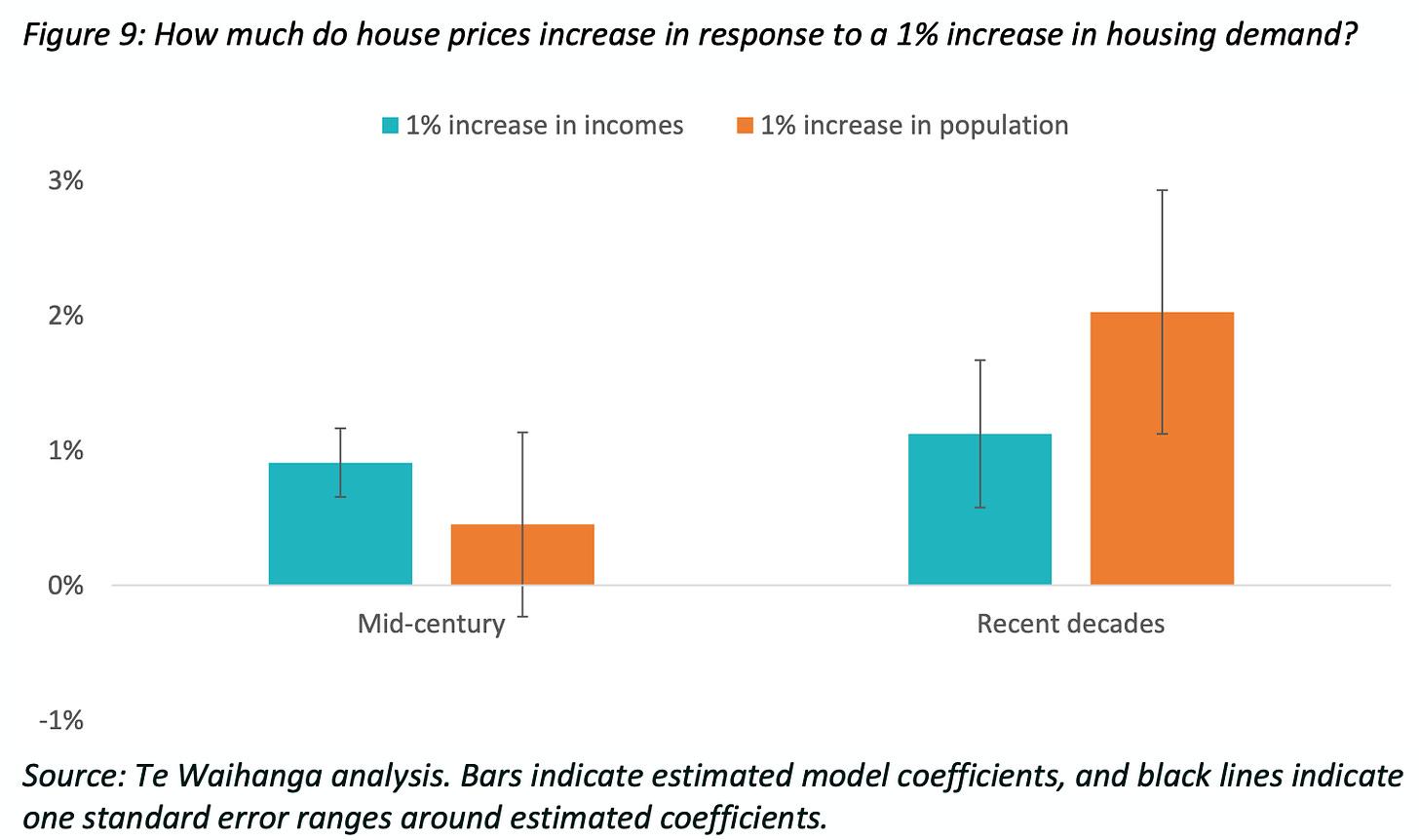TLDR: A research paper from the Te Waihanga (The Infrastructure Commission) has estimated house prices rose 69% more than they would have done if councils had not down-zoned both close to city centres and on the fringes over the 1970s and 1980s to allow fewer houses to built.
Insufficient investment in transport infrastructure over the last 30 years also slowed traffic and commuting speeds from the 1990s onwards, which increased demand for homes closer to the city centre just as the number of new homes close to the centre was broadly frozen.
This is an updated and expanded version of an article that was published for full paid subscribers on Tuesday. It includes an interview I did with Peter yesterday in podcast form above. The Kākā’s fully paid up subscribers support the analytical and accountability journalism I do on analysing housing, climate and poverty, including ensuring it gets out to a wider audience, as is being done with this email sent to free subscribers. It is free and shareable for the public.
Te Waihanga’s Economics Director Peter Nunns published a compelling and detailed 51 page analysis this week showing how decisions by Governments and councils from the 1970s onwards reduced the responsiveness of our housing market to build new houses by a quarter to a third. That slashing of ‘elasticity’ of supply meant a rebound in population growth and low interest rates pushed up house prices by 69% more than would otherwise have been the case.

Nunn’s analysis focuses on decisions by councils in the 1970s, 1980s and 1990s under the Town and Country Planning Act 1973 and the Resource Management Act 1991 to focus on protecting existing houses and land, rather making properly zoned and infrastructured land available for new houses, as they had down in the 1930s, 1940s and 1950s.
"Between 2010 and 2018, we built new homes at a slower rate than population growth, and prices accelerated. The research suggests that now, when housing demand increases, we build a quarter to a third less homes than we used to. Changes to urban planning and transport that started in the 1970s have raised barriers to housing development.
"Until the 1970s, city councils actively encouraged population growth both at the fringe of the cities and in established suburbs. Cars became more affordable and urban roads were paved and improved, allowing people to travel further, faster and boosting development of new suburbs.
"Council plans facilitated infill housing prior to the 1970s but started to limit it after that point. Planning began to focus less on facilitating growth and planning infrastructure, and more on maintaining the character of existing neighbourhoods by stopping the construction of blocks of flats and apartments." Peter Nunns.
What the down-zoning looked like
Nunns analysis looked in detail at how in-infill housing and fringe housing were both restricted in major urban centres over the last 50 years, and how slowing commuting times because of a lack of transport infrastructure investment had helped propel house prices higher closer to city centres.
This chart shows how capacity was squeezed relative to the population in Auckland, up until the 2016 Unitary Plan.
This chart shows how the growth in dwelling stock in particular (because of the rise in the size of each home until recently) was restricted after the 1970s.
This helped lead to an increase in the sensitivity of house prices to rises in demand through higher incomes and higher population.
Nunns analysis also looked at how declining travel speeds because transport infrastructure failed to keep up with population growth had been a factor.
‘If only we had built up and along’
Nunns wrote that changes to urban planning policies and urban transport network performance could explain most, if not all, of the acceleration in house prices and decline in housing supply responsiveness in recent decades.
“If we had not downzoned central Auckland in the 1970s, or if we had chosen to adopt successful congestion-mitigation policies, then housing would now be more abundant and house prices would be lower.” Peter Nunns
Nunns then used the widely used urban economics model known as the Alonso-Muth-Mills (AMM) model to analyse what would have happened without the land use restrictions or declining commuting speeds.
Here’s his explanation of how it works:
“In the model, people choose where in the city to live to minimise their combined housing and transport costs. In equilibrium, nobody stands to gain from moving to a different location. This means that differences in house prices between locations are proportional to differences in the cost, in time and money, to commute from those locations. Places that are further away from the city centre have higher transport costs and hence lower house prices, lower population density, and lowerlandprices.” Peter Nunns.
Nunns then used this model to analyse three counter-factual scenarios and what they would have done to house prices, relative to what actually happened.
“The first counterfactual scenario examines what would have occurred if we had not downzoned central Auckland in the 1970 and 1981 District Schemes. The second examines what would have happened if travel speeds had been maintained at their peak levels, rather than declining in the 1990s and 2000s. The third considers the cumulative effect of avoiding both downzoning and declining travel speeds.
“Table 3 compares these counterfactual scenarios against model predictions based on observed data. The first and second scenario both result in predicted house price growth of roughly 150% over the 1979-2018 period. This represents a 40% reduction in price inflation relative to what actually happened. In the first scenario, this is mainly due to increased housing supply in existing suburbs, but in the second, this is mainly due to increased subdivision on the fringe of the city.
This analysis shows that accelerating house prices were not inevitable – they could have been avoided if we had chosen to adopt different policies. If we had not downzoned central Auckland in the 1970s, or if we had avoided declining urban travel speeds, then urban housing would now be more abundant and house prices would be lower.
“The third scenario results in predicted house price growth of roughly 80% over the 1979-2018 period. This represents a 70% reduction in price inflation relative to what actually happened.” Peter Nunns.
Here’s the ‘money shot’ table illustrating the ‘what if’ scenario
I have a full transcript of the interview above. Please email me if you’d like me to send it to you.



















Share this post